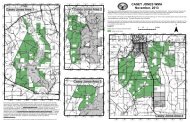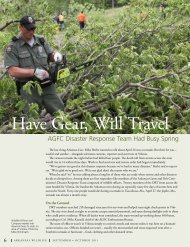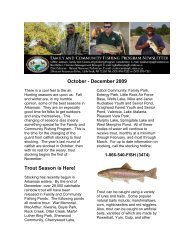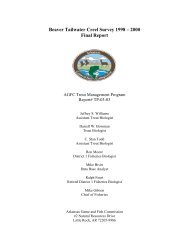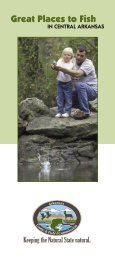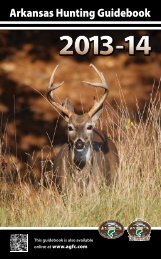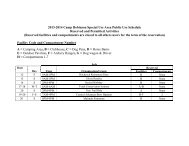2006-07 deer Report - Arkansas Game and Fish Commission
2006-07 deer Report - Arkansas Game and Fish Commission
2006-07 deer Report - Arkansas Game and Fish Commission
- No tags were found...
You also want an ePaper? Increase the reach of your titles
YUMPU automatically turns print PDFs into web optimized ePapers that Google loves.
c=85 m=19 y=0 k=0 c=57 m=80 y=100 k=45 c=20 m=0 y=40 k=6<strong>2006</strong>-<strong>07</strong><strong>Arkansas</strong> <strong>Game</strong> <strong>and</strong> <strong>Fish</strong> <strong>Commission</strong>Deer Season Summary
Deer Decisions Start With DMAPEvery time <strong>deer</strong> hunters choose whether or not to pull a trigger, they make wildlifemanagement decisions. When hunters in an area make the same decisions, they can have adramatic effect on a <strong>deer</strong> herd’s health <strong>and</strong> population.The <strong>Arkansas</strong> <strong>Game</strong> <strong>and</strong> <strong>Fish</strong> <strong>Commission</strong>’s Deer Management Assistance Program helpsl<strong>and</strong>owners <strong>and</strong> hunting clubs make the best decisions for their herds. Participants collect<strong>and</strong> submit biological data from their <strong>deer</strong> harvests, <strong>and</strong> receive customized reports <strong>and</strong>recommendations for future harvests <strong>and</strong> habitat work.The program is voluntary, <strong>and</strong> participation does not affect l<strong>and</strong>-access policies or restrictl<strong>and</strong>-management practices or hunting regulations.DMAP Works Both WaysHunting clubs <strong>and</strong> l<strong>and</strong>owners enrolled in DMAP may receive many benefits, dependingon how much information they give the AGFC. When armed with the right information,biologists can offer recommendations <strong>and</strong> technical support, such as:• Professional advice based on the status of the local <strong>deer</strong> herd• Potential <strong>and</strong> limitations of local <strong>deer</strong> habitat• Recommendations to improve local habitat• Annual reports <strong>and</strong> harvest recommendations to manage the <strong>deer</strong> herd• Recommendations for other species on the propertyEasy EnrollmentContact the private l<strong>and</strong>s biologist in the AGFC regional office nearest the l<strong>and</strong> to be enrolled.The biologist will review the application <strong>and</strong> contact you or your club’s representative.Participants must own or control enough l<strong>and</strong> to effectively manage the <strong>deer</strong> herd (around1,000 contiguous acres). L<strong>and</strong>owners <strong>and</strong> hunting clubs are encouraged to join withneighboring l<strong>and</strong>owners to meet the minimum acreage <strong>and</strong> increase the program’s success.Region 1: Jonesboro(870) 972-5438Toll-free: (877) 972-5438Region 2: Brinkley(870) 734-4581Toll-free: (877) 734-4581Region 3: Monticello(870) 367-3553Toll-free: (877)367-3559Region 4: Camden(870) 836-4612Toll-free: (877) 836-4612Region 5: Perrytown(870) 777-5580Toll-free: (877) 777-5580Region 6: Hot Springs(501) 525-8606Toll-free: (877) 525-8606Region 7: Fort Smith(479) 478-1043Toll-free: (877) 478-1043Region 8: Russellville(479) 967-7577Toll-free: (877) 967-7577Region 9: Calico Rock(870) 297-4331Toll-free: (877) 297-4331Region 10: Eureka Springs(479) 253-2506Toll-free: (866) 253-2506
Table of Contents5 Executive SummarySection One: Harvest Results8 Harvest Results for <strong>2006</strong>-<strong>07</strong>9 Historic Deer Harvest 1938-<strong>2006</strong>10 Statewide Harvest by Method11 Statewide Harvest by Zone12 Statewide Harvest by Opening Date13 Statewide Harvest by Month13 Statewide Harvest by County14 Deer Management Units14 Harvest Density by DMU15 Harvest by WMASection Two: Herd Health <strong>Report</strong>s18 Herd Health Data Collection19 Average Kidney Fat Index by DMU20 Average Date of Conception by DMU21 Average Number of Fetuses per Doe by DMUSection Three: Biological Data <strong>Report</strong>s22 Biological Data Collection23 Age Structure by Sex <strong>and</strong> DMU24 Average Buck Dressed Weight by DMU25 Average Antler Index by DMU26 Average Doe Dressed Weight by DMU27 Average Doe Lactation by DMU
Table of ContentsSection Four: Bowhunter Observation Data28 Observation Data Collection28 Comparison of 2005-06 <strong>and</strong> <strong>2006</strong>-<strong>07</strong> ObservationsSection Five: Focus on Deer29 Rick Evans Gr<strong>and</strong>view Prairie WMAwww.agfc.comThe <strong>Arkansas</strong> <strong>Game</strong> <strong>and</strong> <strong>Fish</strong> <strong>Commission</strong> <strong>2006</strong>-<strong>07</strong> Deer Season Summary is also available on ourWeb site in Portable Document Format (PDF) at www.agfc.com/<strong>deer</strong>.Cover photo by John Ford.
Executive SummaryIn 1999 the <strong>Arkansas</strong> <strong>Game</strong> <strong>and</strong> <strong>Fish</strong><strong>Commission</strong> approved the StrategicDeer Management Plan. The majorpurpose of this plan is to provide strategic,long-term guidance <strong>and</strong> direction for the<strong>Commission</strong>’s white-tailed <strong>deer</strong> program.The Strategic Deer Management Plan dividesthe state into six Deer Management Units (DMU)based on the following physiographic regions: OzarkMountains, Ouachita Mountains, <strong>Arkansas</strong> RiverValley (ARV), West Gulf Coastal Plain (WGCP),Mississippi Alluvial Valley (Delta), <strong>and</strong> Crowley’sRidge (CR). The statewide zones are subdivisionsof the DMUs. Zones allow separate managementstrategies to address differences in <strong>deer</strong> populations,habitat composition, <strong>and</strong> l<strong>and</strong>-use patterns withineach DMU to maintain the established population<strong>and</strong> biological goals.Current ManagementAll regions of <strong>Arkansas</strong> support white-tailed <strong>deer</strong>populations. The highest densities occur in the WestGulf Coastal Plain where about 50 percent of allharvest occurs. The <strong>deer</strong> populations in the OzarkMountains, Ouachita Mountains <strong>and</strong> the <strong>Arkansas</strong>River Valley are considered stable to increasing.Despite the high degree of habitat fragmentation,the Mississippi Alluvial Valley supports a moderate<strong>deer</strong> population, primarily because of high soilfertility <strong>and</strong> high-quality food sources. Crowley’sRidge has soil types <strong>and</strong> habitat compositiondrastically different than the surroundingMississippi Delta. The <strong>deer</strong> population on Crowley’sRidge is considered stable.The <strong>deer</strong> database contains 69 years of harvestdata, 17 years of biological data (body weights,lactation, age <strong>and</strong> antler measurements), 6 yearsof herd health data (kidney fat indices, conceptiondates, parturition dates <strong>and</strong> fetal counts), <strong>and</strong> 3years of bowhunter observation data. Because oflack of st<strong>and</strong>ardization of <strong>deer</strong> zone boundariesthroughout the years, data analysis by <strong>deer</strong> zone isdifficult. Data available can best be evaluated byDMU because of unchanging boundaries.A total of 165,663 <strong>deer</strong> were checked in the<strong>2006</strong>-<strong>07</strong> <strong>deer</strong> season. This represents a 25 percentincrease from the 2005-06 harvest of 132,415. Thebuck harvest increased 26 percent (90,028) fromthe 2005-06 harvest of 71,253. The doe harvestincreased 28 percent (47,778 to 61,179) during the<strong>2006</strong>-<strong>07</strong> season. Button buck harvest increased12 percent (12, 747 from the 2005-06 harvestof 11,428).“A total of 165,663 <strong>deer</strong>were checked in the<strong>2006</strong>-<strong>07</strong> <strong>deer</strong> season.”The <strong>2006</strong>-<strong>07</strong> biological data demonstrates themajority of bucks (36 percent) <strong>and</strong> does (25 percent)harvested statewide were 2.5 years old. The peakin the 2.5-year-old buck harvest is primarily aresult of the statewide antler point restriction thatdefines a legal buck as having at least three pointson one side. Average dressed body weights for adultbucks ranged from 109 pounds in the OuachitaMountains <strong>and</strong> the West Gulf Coastal Plain to 131pounds in the Mississippi Alluvial Valley. Averageadult doe dressed body weights were highest inthe Mississippi Alluvial Valley (89 pounds) <strong>and</strong>lowest in the Ouachita Mountains (77 pounds).Statewide lactation rates in adult does were belowthe 80 percent target set by the Strategic DeerPlan. The highest adult lactation was 78 percent5
Executive Summaryin the Mississippi Alluvial Valley; the lowestadult lactation was 58 percent in the OuachitaMountains. Antler index is the sum of total numberof points, inside spread, left beam length, <strong>and</strong> leftbeam circumference. The highest average score was47 on Crowley’s Ridge; the lowest average score was39 in the West Gulf Coastal Plain.Herd Health Data SummaryHerd health data provides information on herdhealth conditions, timing of the rut, <strong>and</strong> fawnproduction. For 20<strong>07</strong>, the average number of fetusesproduced was highest in the Ozarks (2.0) <strong>and</strong>the lowest was in the Ouachita Mountains (1.16).Kidney Fat Indices (KFI) range from a high of127 percent in the Ozark Mountains to a low of33 percent in the Ouachita Mountains. Kidney fatdeposits can be used to evaluate physical conditionsof animals coming out of winter stress enteringspring green-up. Mast production <strong>and</strong> weatherconditions will determine amount of fat depositsprior to spring. The minimum desired average KFIfor a sampling period of February through April is35 percent.The peak rut in <strong>2006</strong> was similar when comparedto the five-year average in some areas. TheOzark Mountains showed the earliest peak rut atNovember 5. The latest peak rut in <strong>Arkansas</strong> wasin the Mississippi Alluvial Valley on November26. This is common. Deer in the delta <strong>and</strong> battureregions of <strong>Arkansas</strong> have historically bred latercompared to other regions. Some biologists believethe reason for this late rutting is because historicalflooding results in fawns being born later or afterthe water recedes.<strong>and</strong> antler structure. This kind of population data,along with biological data from harvested <strong>deer</strong>,provides a more detailed picture of the <strong>deer</strong> herdfor each region. More than 1,000 archery huntersparticipated in the survey <strong>and</strong> collected more than14,000 hours of data. It is important to stress thatthe information presented in this report representsonly three years of observation data. Additional datawill be needed to determine trends <strong>and</strong> potentialchange related to management strategies.Chronic Wasting Disease UpdateChronic Wasting Disease (CWD) is still amajor concern <strong>and</strong> threat to <strong>Arkansas</strong>’s native <strong>deer</strong>populations. During 2004-06 biologists completeda r<strong>and</strong>om sampling of each of <strong>Arkansas</strong>’s counties.Within each county a minimum of 50 sampleswere collected from hunter-harvested <strong>deer</strong> <strong>and</strong> herdhealth <strong>deer</strong> sampled in late winter. During <strong>2006</strong>,biologists collected samples from “hot spots” or areasof concern <strong>and</strong> worked to collect additional samplesin areas where sample collection was not adequatelydistributed geographically. To date, more than 3,700wild <strong>deer</strong> have been tested in USDA-certified labs atthe <strong>Arkansas</strong> Livestock <strong>and</strong> Poultry <strong>Commission</strong> <strong>and</strong>the University of Georgia. No evidence of CWD hasbeen detected in any of these samples.Bowhunter Observation SummaryThe <strong>2006</strong>-<strong>07</strong> archery season was the third year inwhich hunters throughout the state collected <strong>deer</strong>observation data. Hunter observations provide datasuch as sex ratios, <strong>deer</strong> density, fawn-to-doe ratio6
Executive SummaryFuture Management Plans: Update20<strong>07</strong> Deer Plan RevisionThe Wildlife Management Division has initiatedthe process to revise the agency’s Strategic DeerManagement Plan in 20<strong>07</strong>. The process selected willincorporate public input data <strong>and</strong> biological parametersto produce a final product.AGFC has contracted the services of DynamicSolutions Group, a consulting firm that workswith natural resources agencies around the countryto develop management strategies while forgingrelationships with the public. The group has worked onhot-item issues such as wolf management in Utah <strong>and</strong>Wyoming, but one of its specialties is increasing publicinvolvement during the development of fish <strong>and</strong> wildlifemanagement plans.Traditionally, species plans are developed by AGFCbiologists with public input incorporated on the tailendof plan development. This new approach involvesgathering public input data during the initial stages <strong>and</strong>merging the public’s input with biology to produce astatewide plan.The process started by developing advisory groupsincluding various stakeholders from each physiographicregion of <strong>Arkansas</strong>. The advisory groups act as asounding board for the AGFC <strong>and</strong> assist with pl<strong>and</strong>evelopment <strong>and</strong> implementation.The next step was a series of 10 public scopingworkshops held in June, 20<strong>07</strong>. These workshopsgathered public input that will assist in the developmentof the plan.A second round of public meetings will be heldfollowing the completion of the draft managementplan with a <strong>deer</strong> summit meeting scheduled forSept. 29, 20<strong>07</strong>. The summit meeting will includeinformation on implementing the plan, but willfocus on thanking participants for their assistancewith plan development.The process is expected to be complete by December20<strong>07</strong>, when the final draft of the management plan willbe presented to AGFC commissioners for approval.With white-tailed <strong>deer</strong> being the highest-profilegame animal in The Natural State <strong>and</strong> with more than300,000 <strong>deer</strong> hunters pursuing whitetails each year, theAGFC believes that this new approach will allow thehunters to become vested in <strong>Arkansas</strong>’s <strong>deer</strong> resource.Deer Management Assistance Program(DMAP) Data ProgramThe AGFC Wildlife Management Division hasmade great strides in achieving this goal. We havecontracted the services of well known computerprogrammers to develop a program to reduce theamount of time biologists invest in data analysis <strong>and</strong>provide hunting clubs a professional <strong>and</strong> valuablereport of <strong>deer</strong> herd condition.Wildlife Management AreaPermit Hunt <strong>Report</strong>ingDuring the <strong>2006</strong>-<strong>07</strong> season many hunters whoparticipated in a permitted hunt completed a hunter-usesurvey. Biologists responsible for these areas also havebeen collecting harvest data. This is an ongoing effortto gather information related to permit administration<strong>and</strong> <strong>deer</strong> management goals.Develop <strong>Arkansas</strong>’s CWD Sampling <strong>and</strong>Response Plan<strong>Arkansas</strong>’s CWD Task Force completed this goalin 20<strong>07</strong>. The plan is currently available for review onwww.agfc.com. The purpose of this plan is to provideguidance for future CWD monitoring <strong>and</strong> a response ifa positive sample is found.Evaluation of the Three-Point RuleThe AGFC has been working with the University of<strong>Arkansas</strong> at Monticello to review the three-point antlerregulation’s effect on age composition <strong>and</strong> antler size.This project is scheduled for completion late in 20<strong>07</strong>.7
Section One: Harvest ResultsHarvest Results for <strong>2006</strong>-<strong>07</strong>A total of 165,663 <strong>deer</strong> were checked in the<strong>2006</strong>-<strong>07</strong> <strong>deer</strong> season. This is a 25 percent increasefrom the 2005-06 harvest of 132,415. The buckharvest increased 26 percent (90,028) from the2005-06 harvest of 71,253. The doe harvestincreased by 28 percent (47,778 to 61,179).Button buck harvest increased 12 percent (12, 747from the 2005-06 harvest of 11,428). One reasonfor the increase in buck harvest is the bag limitincrease to two bucks in zones 1, 2, 6, 7, 8 <strong>and</strong> 10.These zones exhibited a total increase of 10, 644bucks from the 2005-06 season.Deer Harvest in <strong>Arkansas</strong>, 1990-20<strong>07</strong>1990-20<strong>07</strong> Deer Harvest250,000High: 194,687200,000<strong>2006</strong>-<strong>07</strong>:165,663Number Harvested150,000100,000Low: 90,91050,00001990 1991 1992 1993 1994 1995 1996 1997 1998 1999 2000 2001 2002 2003 2004 2005 <strong>2006</strong>Year8
Section One: Harvest ResultsHistoric Deer Harvest1938-<strong>2006</strong>YearTotalHarvestYearTotalHarvestYearTotalHarvestYearTotalHarvest1938 203 1956 8,249 1974 33,763 1992 110,4011939 540 1957 9,438 1975 33,322 1993 122,0631940 408 1958 9,993 1976 27,790 1994 120,4911941 433 1959 12,280 1977 29,109 1995 163,9241942 1,000 1960 15,000 1978 43,452 1996 152,4601943 1,723 1961 19,359 1979 36,<strong>07</strong>4 1997 167,3051944 1,606 1962 27,772 1980 45,202 1998 179,2251945 1,687 1963 25,148 1981 44,591 1999 194,6871946 1,661 1964 16,637 1982 42,873 2000 182,1321947 2,016 1965 17,138 1983 60,248 2001 150,2791948 2,779 1966 20,028 1984 66,039 2002 124,4511949 3,<strong>07</strong>5 1967 21,751 1985 60,<strong>07</strong>6 2003 108,4561950 4,122 1968 20,063 1986 79,880 2004 131,6391951 4,600 1969 25,696 1987 106,392 2005 132,4151952 6,090 1970 26,017 1988 110,2<strong>07</strong> <strong>2006</strong> 165,6631953 6,245 1971 24,720 1989 113,<strong>07</strong>91954 7,343 1972 32,087 1990 90,9101955 6,856 1973 33,794 1991 110,8969
Section One: Harvest ResultsStatewide Harvest by Method<strong>2006</strong>-<strong>07</strong>Method BucksButtonBucksDoes Unknown TotalArchery 4,142 621 5,770 81 10,614Crossbow 1,717 427 2,412 52 4,608Muzzleloader 14,<strong>07</strong>6 1,585 8,951 239 24,851Modern Gun 68,661 9,842 43,015 1,155 122,673Unknown 1,432 272 1,031 182 2,917Entire Season 90,028 12,747 61,179 1,709 165,663Percent of Total Harvest 54% 8% 37% 1%2005-06Method BucksButtonBucksDoes Unknown TotalArchery 2,974 528 4,291 131 7,924Crossbow 1,258 394 1,998 57 3,7<strong>07</strong>Muzzleloader 7,432 1,118 5,361 1,029 14,940Modern Gun 58,816 9,246 35,579 67 103,708Unknown 773 142 549 672 2,136Entire Season 71,253 11,428 47,778 1,956 132,415Percent of Total Harvest 54% 9% 36% 1%Statewide Harvest by MethodDifference by Percent from 2005-06 SeasonMethod% DifferenceBucks% DifferenceButton Bucks% DifferenceDoes% DifferenceTotalArchery 39% 18% 34% 34%Crossbow 36% 8% 21% 24%Muzzleloader 89% 42% 67% 66%Modern Gun 17% 6% 21% 18%Unknown 85% 92% 88% 37%Entire Season 26% 12% 28% 25%10
Section One: Harvest ResultsStatewide Harvest by ZoneBucks Button Bucks Does Unknown TotalZone Harvest % Change Harvest % Change Harvest % Change Harvest % Change Harvest % Change1*2*344A55A6*7*8*910*11121314151616A17WMAUnknownTotal2,0094,1711,2992,8936,5358,7864956222262271,0441,2231851953,5137,3861,1012,0032,3223,9554,1934,3217521,2323,8083,72029,32332,9085,2326,2391,5861,99<strong>07</strong>919526347282042061,2771,4543,2904,1591,43465871,25390,028108%123%34%26%0%17%5%110%82%70%3%64%-2%12%19%25%20%15%1%14%26%-54%26%1031839216080<strong>07</strong>3285992421262263191621334472144231308494609671152682586,5357,2158521,0<strong>07</strong>22627511816068671712949956654122211911,42812,74778%74%-9%16%-13%0%-16%62%100%33%23%72%-4%10%18%22%36%-1%-29%5%-4%-46%12%* Buck bag limit increase from one buck to two bucks.8028505276102,4652,6853864791101389631,02976811,4551,8004165951,2381,4012,7233,3404305737711,11624,81932,4633,3935,6011,1611,5425598134957701161331,5641,7332,2672,8921,04253547,77861,1796%16%9%24%25%7%7%24%43%13%23%33%45%31%65%33%45%56%15%11%28%-49%28%35695840180118121134513125118699622553864941118347965<strong>07</strong>67951413821251561721303113386258321,9561,7092005-06 Data <strong>2006</strong>-<strong>07</strong> Data97%-31%-34%-8%33%-39%150%-42%-77%-31%47%64%132%18%48%-45%-40%183%-50%3%-35%-88%-13%2,9495,2731,9763,7039,98012,3219781,2113633902,3202,5462822975,2999,5991,6852,7643,8465,7027,4748,3641,2601,9384,8815,17361,32773,3539,57212,9883,0113,8281,4931,9401,2031,5823393522,9653,3176,2567,6782,9561,344132,415165,66379%87%23%24%7%10%5%81%64%48%12%54%6%20%36%27%30%32%4%12%23%-55%25%11
Section One: Harvest ResultsStatewide Harvest by Opening DateThe <strong>2006</strong>-<strong>07</strong> <strong>deer</strong> season was the fourth seasonscannable checksheets were used. In addition to easeof use, faster data processing <strong>and</strong> near real-time datareporting, the scanning process enabled the AGFC toanalyze <strong>deer</strong> harvest by date. This information willallow the agency to chart opening day trends. It alsowill provide valuable details about the effects of seasonstructure on harvest. The most noteworthy findingfrom the <strong>2006</strong>-<strong>07</strong> harvest by date was that 15 percentof the total harvest occurred on the opening days ofmuzzleloader <strong>and</strong> modern gun seasons.Statewide Harvest by Opening DateMethod Opening Day HarvestAverageTemp. (F)AveragePrecipitationPeak Wind(MPH)2003-04 SeasonArchery/Crossbow Oct. 1, 2003 562 57 0 23Muzzleloader Oct. 18, 2003 4,394 60 0 9Modern Gun Nov. 8, 2003 18,222 49 0 172004-05 SeasonArchery/Crossbow Oct. 1, 2004 989 70 0 17Muzzleloader Oct. 16, 2004 5,754 60 0 20Modern Gun Nov. 13, 2004 19,636 49 0.01 242005-06 SeasonArchery/Crossbow Oct. 1, 2005 1,161 71 0 15Muzzleloader Oct. 15, 2005 2,730 70 0 14Modern Gun Nov. 12, 2005 16,724 59 0.14 28<strong>2006</strong>-<strong>07</strong> SeasonArchery/Crossbow Oct. 1, <strong>2006</strong> 1,215 90 0 4Muzzleloader Oct. 14, <strong>2006</strong> 5,936 72 0 4Modern Gun Nov. 11, <strong>2006</strong> 19,857 60 0 912
Section One: Harvest ResultsStatewide Harvest by Month<strong>2006</strong>-<strong>07</strong>Month Harvest % Total Month Harvest % TotalOctober 31,767 19.18% January 1,422 0.86%November 101,766 61.43% February 612 0.37%December 30,096 18.17%<strong>2006</strong>-<strong>07</strong> Deer HarvestDeer Harvested by County<strong>2006</strong>-20<strong>07</strong> Statewide Harvest by CountyMap 1BENTON1,867WASHINGTON2,643CRAW-FORD1,712SEBAS-TIAN987SCOTT767POLK1,830SEVIER1,682MADISON2,406FRANK-LIN1,228HOW-ARD2,908LOGAN1,193PIKE3,801YELL1,544NEWTON1,220POPE1,868CLARK5,795SALINE3,408UNION7,363PULASKI1,519GRANT4,604STONE1,319IZARD1,539WHITE2,754LONOKE1,105DESHAHEMP-LITTLE2,166STEADRIVERNEVADA OUACHITA3,1652,067 4,171 5,477DREWLowest Harvest5,037CALHOUN4,852MILLER1,337CARROLL950MONT-GOMERY1,052JOHNSON1,545LAFAY-ETTE1,772BOONE851GARLAND2,206COLUMBIA4,444PERRY842MARION1,049HOT SPRING2,483*Unknown County Harvest- 1,546SEARCY953CONWAY1,445DALLAS5,9<strong>07</strong>BAXTER1,451VAN BUREN1,803FAULK-NER1,441FULTON2,330CLEBURNE1,974CLEVELAND5,775JEFFERSON2,856BRADLEY5,520LINCOLN2,646ASHLEY4,964SHARP2,678INDEPEN-DENCE2,250PRAIRIE2,122ARKANSAS3,756RANDOLPH1,626LAWRENCE1,205JACK-SON334WOOD-RUFF878MON-ROE1,361CHICOT936CROSS596LEE495PHILLIPS505CLAY958GREENE1,127CRAIGHEAD317POINSETT442ST. FRANCIS604CRITTEN-DEN196MISSISSIPPI138Greatest Harvest13
Section One: Harvest ResultsDeer Management UnitsThe 1999 Strategic Deer Management Pl<strong>and</strong>efined Deer Management Units (DMUs) based onthe following <strong>Arkansas</strong> physiographic regions: OzarkMountains, Ouachita Mountains, <strong>Arkansas</strong> RiverValley, West Gulf Coastal Plain, Mississippi AlluvialValley (Delta), <strong>and</strong> Crowley’s Ridge (see Map 2).The Strategic Deer Management Plan establishedlong-term <strong>deer</strong> biological <strong>and</strong> population goalsfor each DMU. The statewide <strong>deer</strong> zones aresubdivisions of the DMUs. Zones allow for separatemanagement strategies to address current differencesin <strong>deer</strong> populations, harvests, habitats <strong>and</strong> l<strong>and</strong> usewithin each DMU while striving to maintain theestablished population <strong>and</strong> biological goals.Deer Management UnitsAnd the <strong>2006</strong>-<strong>07</strong> Deer ZonesMap 2Harvest DensityUsing Geographic Information Systems (GIS)technology, we were able to analyze the 2003-20<strong>07</strong><strong>deer</strong> harvest by total acreage for the DMUs. TheWest Gulf Coastal Plain was the most productive2003-<strong>07</strong> Total AcresPer Deer Harvest by DMUDMU with a yield of one <strong>deer</strong> harvested for every126 acres (see Map 3). This four-year averageprovides information regarding the productivitylevels of each DMU.Map 314
Section One: Harvest ResultsPublic L<strong>and</strong> Harvest<strong>2006</strong>-<strong>07</strong>WMA Name Harvest AcresBald Knob NWR 17 15,000Bayou Des Arc WMA 5 953Bayou Meto WMA 177 33,832Beaver Lake WMA 11 5,827Bell Slough WMA 6 2,040Benson Creek Natural Area WMA 3 302Beryl Anthony Lower Ouachita WMA 2 7,020Big Creek WMA 11 280Big Lake WMA 6 12,320Big Timber WMA 241 37,742Blevins WMA 3 128Blue Mountain WMA 25 8,200Buffalo National River WMA 50 95,730Cache River NWR 142 54,000Camp Robinson SUA 44 4,029Camp Robinson WMA 267 26,675Caney Creek WMA 66 85,000Casey Jones WMA 144 83,832Cattail Marsh WMA 1 78Cedar Creek WMA 4 103Cherokee Prairie Natural Area WMA 2 130Cherokee WMA 46 105,313Choctaw Isl<strong>and</strong> WMA 90 8,300Crossett Experimental Forest WMA 7 1,675Cut-off Creek WMA 53 9,314Cypress Bayou WMA 7 1,503Dagmar WMA 48 9,720Dardanelle WMA 31 42,500Dave Donaldson Black River WMA 76 21,150Departee Creek WMA 3 450Devil’s Knob Natural Area WMA 1 499Dr. Lester Sitzes III Bois D’Arc WMA 71 13,646Earl Buss Bayou DeView WMA 18 4,435Ed Gordon Point Remove WMA 139 8,694Felsenthal NWR 520 65,000Fort Chaffee WMA 475 66,000Continued next page >>15
Section One: Harvest ResultsPublic L<strong>and</strong> Harvest<strong>2006</strong>-<strong>07</strong>WMA Name Harvest AcresFrog Bayou WMA 1 790Galla Creek WMA 27 3,329Gene Rush WMA 19 18,190Greers Ferry Lake WMA 7 9,914Gulf Mountain WMA 131 11,683Gum Flats WMA 24 15,661Harold E. Alex<strong>and</strong>er Spring River WMA 95 13,859Henry Gray Hurricane Lake WMA 100 17,524Hobbs State Park-Conservation Area 19 11,744Holla Bend NWR 65 7,000Holl<strong>and</strong> Bottoms WMA 34 6,190Hope Upl<strong>and</strong> WMA 18 2,115Howard County WMA 132 26,000Howard Hensley Searcy County WMA 2 170Iron Mountain Natural Area WMA 2 161J. Perry Mikles Blue Mountain SUA 19 4,000Jamestown Independence County WMA 2 971Jim Kress WMA 14 14,527Jones Point WMA 3 1,200Lafayette County WMA 58 16,739Lake Greeson WMA 235 38,000Lee County WMA 2 200Little Bayou WMA 3 1,284Little River WMA 5 597Loafer’s Glory WMA 4 2,616Madison County WMA 58 14,496Mike Freeze Wattensaw WMA 218 19,184Mount Magazine WMA 168 120,000Muddy Creek WMA 129 146,206Nimrod Lloyd Millwood WMA 2 3,550Norfork Lake WMA 26 10,000Overflow NWR 9 13,000Ozark Lake WMA 1 7,834Ozark National Forest WMA 348 678,878Petit Jean River WMA 58 15,502Pine City Natural Area WMA 3 593Continued next page >>16
Section One: Harvest ResultsPublic L<strong>and</strong> Harvest<strong>2006</strong>-<strong>07</strong>WMA Name Harvest AcresPiney Creeks WMA 133 180,000Poison Springs WMA 96 17,604Pond Creek NWR 95 27,000Prairie Bayou WMA 3 453Provo WMA 82 11,327R. L. Hankins Mud Creek Upl<strong>and</strong> WMA 11 1,023Railroad Prairie Natural Area WMA 1 244Rainey WMA 2 488Rex Hancock Black Swamp WMA 15 7,221Rick Evans Gr<strong>and</strong>view Prairie WMA 14 4,895River Bend WMA 1 104Seven Devils WMA 27 5,032Shirey Bay Rainey Brake WMA 66 10,711Slippery Hollow Natural Area WMA 2 240Smoke Hole Natural Area WMA 1 455Spring Bank WMA 3 701St. Francis National Forest WMA 29 21,201St. Francis Sunken L<strong>and</strong>s WMA 24 27,361Steve N. Wilson Raft Creek Bottoms WMA 3 4,000Sulphur River WMA 128 16,520Sylamore WMA 230 150,000Terre Noire Natural Area WMA 1 77Trusten Holder WMA 124 8,173Two Bayou Creek WMA 1 1,250U of A Pine Tree Experimental Station WDA 87 11,850W. E. Brewer Scatter Creek WMA 6 3,898Wapanocca NWR 10 5,485Warren Prairie Natural Area WMA 47 889Wedington WMA 29 16,000White Cliffs Natural Area WMA 4 573White River NWR 846 160,000White Rock WMA 475 280,000Whitehall WMA 2 111Winona WMA 226 160,000Wittsburg Natural Area WMA 1 167Total 7,678 3,220,18017
Section Two: Herd Health <strong>Report</strong>sHerd Health Data CollectionHerd health data providesinformation on herd healthconditions, timing of the rut<strong>and</strong> fawn production.<strong>Arkansas</strong> <strong>Game</strong> <strong>and</strong> <strong>Fish</strong> <strong>Commission</strong> personnelhave collected several hundred <strong>deer</strong> samples duringthe last six years in late winter <strong>and</strong> early spring togauge herd health. Samples were collected from all sixDMUs in the state. All usable meat was donated toFarmers <strong>and</strong> Hunters Feeding the Hungry or needyfamilies within the community.Kidney Fat Index: Kidney Fat Index (KFI) canbe used to evaluate physical conditions of <strong>deer</strong>coming out of winter stress, <strong>and</strong> entering springgreen-up. KFI is the weight of the fat depositssurrounding the kidneys divided by the weightof the kidneys, <strong>and</strong> isexpressed as a percentage.The higher the KFIvalue, the healthier the<strong>deer</strong>. Targets for KFI aretime sensitive, but forthe sampling period ofFebruary through April thetarget is 35 percent.Conception Date:Fetuses are extracted <strong>and</strong>then measured using aJIM-GEM fetus scaleto determine days fromconception <strong>and</strong> days untilbirth. Conception dataprovides “peak rut” dates,which assist biologistsin making managementdecisions such as setting<strong>deer</strong> season. Conceptiondates will vary from year to year <strong>and</strong> are dependenton population density. Ideally, adult does shouldbreed during their first estrus cycle (November)which results in fawns born during early summer(June). Fawns born during hot summer months(July <strong>and</strong> August) have decreased survival ratesbecause of poor habitat conditions <strong>and</strong> extremeheat.Fetal Counts: The number of fetuses per doe is ameasure of breeding success <strong>and</strong> health of the animal.The number of fetuses per yearling doe is slightlylower than adults, but this is common because oftheir developmental stage. There is little regionalvariation for this among DMUs, indicating breedingsuccess is uniform across the state. The target for fetalcounts is 1.7 per doe.Fred Hicks18
Section Two: Herd Health <strong>Report</strong>s2002-<strong>07</strong> Deer Herd Health:Average Kidney Fat Index by DMUSix-year Averagefor Adults (2.5+ years)Six-year Averagefor Yearlings (1.5 years)93%85%89%61%108%111%96%84%59%55%78%55%20<strong>07</strong> Adult Kidney Fat Indices Compared to Five-year Average by DMU140120100Percent KFI80602002-<strong>2006</strong>20<strong>07</strong>40Target35%200Ozarks Ouachitas ARV WGCP MAV CRDMU19
Section Two: Herd Health <strong>Report</strong>s2002-<strong>07</strong> Deer Herd Health:Average Date of Conception by DMUSix-year Averagefor Adults (2.5+ years)Six-year Averagefor Yearlings (1.5 years)November 10November 20November 22December 26November 11November 15November 27December 2November 13November 15November 19November 14<strong>2006</strong>-<strong>07</strong> Adult Average Date of Conception Compared to Five-year Average by DMU302520November Date15102002-<strong>2006</strong>20<strong>07</strong>50Ozarks Ouachitas ARV WGCP MAV CRDMU20
Section Two: Herd Health <strong>Report</strong>s2002-<strong>07</strong> Deer Herd Health:Average Fetuses by DMUSix-year Averagefor Adults (2.5+ years)Six-year Averagefor Yearlings (1.5 years)1.81.91.3.91.81.41.7.91.61.31.71.120<strong>07</strong> Adult Average Number of Fetuses Compared to Five-year Average by DMU2.01.81.6Target1.71.4Number of Fetuses1.21.00.82002-<strong>2006</strong>20<strong>07</strong>0.60.40.20.0Ozarks Ouachitas ARV WGCP MAV CRDMU21
Section Three: Biological Data <strong>Report</strong>sBiological DataCollectionEach <strong>deer</strong> season wildlifemanagement employees, alongwith participating <strong>deer</strong> clubs,collect a variety of data from harvested<strong>deer</strong>.The data collected includes age, body weight,antler measurements <strong>and</strong> lactation rates. Theseindices make it possible to analyze differences inthe biological characteristics of <strong>Arkansas</strong>’s <strong>deer</strong> overtime <strong>and</strong> among DMUs.Age Structure: Average age structure is directlyrelated to harvest. Buck age structure depends onharvest criteria such as the three-point rule. Beforethe three-point rule was implemented, yearlingswere 80 percent of total buck harvest. In does, theaverage age harvested provides information on theage structure <strong>and</strong> potential recruitment rates.Dressed Body Weight: Average dressed bodyweights vary with environmental conditions such assoil fertility, weather conditions <strong>and</strong> available mast.Bucks can experience extreme wieght loss duringbreeding season because they focus less on eating<strong>and</strong> more on establishing territories <strong>and</strong> monitoringreceptive does. Body weights in does also fluctuatefrom breeding requirements, lactation <strong>and</strong> availablefood nutrition. The target for average buck dressedweight is 110 pounds, except in the MississippiAlluvial Valley where it is 130 pounds. The targetdressed weight in does is 80 pounds statewide <strong>and</strong>90 pounds in the Mississippi Alluvial Valley.Antler Index: Antler index is the sum of totalpoints, inside spread, left beam length <strong>and</strong> leftbeam circumference. Antler indices vary by regiondepending on environmental conditions, such asnutrition. Other factors include age <strong>and</strong> genetics.Elaine R. TaylorLactation: Lactation is an indicator of asuccessfully bred doe. Lactation rates tend to be muchhigher in adult <strong>deer</strong> (2.5+ years old) than in yearlings(1.5 years old). Lactation data is collected onlyduring October <strong>and</strong> November to ensure accuratedeterminations. Target lactation is 80 percent wet foradults <strong>and</strong> 25 percent wet for yearlings.22
Section Three: Biological Data <strong>Report</strong>s<strong>2006</strong>-<strong>07</strong> Deer Biological Data:Age Structure by Sex <strong>and</strong> DMUAverage Adult Buck AgeAverage Adult Doe Age3.53.93.93.53.53.84.04.43.53.93.74.4<strong>2006</strong>-<strong>07</strong> Statewide Age Structure40%35%30%Percentage of Total25%20%15%BucksDoes10%5%0%Fawn 1.5 2.5 3.5 4.5 5.5 6.5+Age (Years)23
Section Three: Biological Data <strong>Report</strong>s2000-06 Deer Biological Data:Average Buck Dressed Weight by DMUSeven-year Averagefor Adults (2.5+ years)Seven-year Averagefor Yearlings (1.5 years)110 lbs.130 lbs.88 lbs.93 lbs.110 lbs.87 lbs.131 lbs.93 lbs.109 lbs.83 lbs.109 lbs.83 lbs.Adult (2.5+) Average Buck Dressed Weight by DMU150140Weight (lbs.)130120110100908<strong>07</strong>0605040302010Target130 lbs.Target110 lbs.2000-2005<strong>2006</strong>0Ozarks Ouachitas ARV WGCP MAV CRDMU24
Section Three: Biological Data <strong>Report</strong>s2000-06 Deer Biological Data:Average Antler Index by DMUSeven-year Averagefor Adults (2.5+ years)Seven-year Averagefor Yearlings (1.5 years)404627284127442341263923Adult Average Antler Index by DMU50454035Antler Index3025202000-2005<strong>2006</strong>151050Ozarks Ouachitas ARV WGCP MAV CRDMU25
Section Three: Biological Data <strong>Report</strong>s2000-06 Deer Biological Data:Average Doe Dressed Weight by DMUSeven-year Averagefor Adults (2.5+ years)Seven-year Averagefor Yearlings (1.5 years)82 lbs.85 lbs.72 lbs.73 lbs.80 lbs.71 lbs.89 lbs.76 lbs.77 lbs.67 lbs.80 lbs.69 lbs.Adult (2.5+) Average Doe Dressed Weight by DMU1009080Target90 lbs.Target80 lbs.70Weight (lbs.)6050402000-2005<strong>2006</strong>3020100Ozarks Ouachitas ARV WGCP MAV CRDMU26
Section Three: Biological Data <strong>Report</strong>s2001-06 Deer Biological Data:Average Doe Lactation by DMUSix-year Averagefor Adults (2.5+ years)Six-year Averagefor Yearlings (1.5 years)66%68%16%23%65%17%65%19%62%11%67%17%Adult Percent Lactation by DMU100%90%80%Target80%70%Percent Lactation60%50%40%2001-2005<strong>2006</strong>30%20%10%0%Ozarks Ouachitas ARV WGCP MAV CRDMU27
Section Five: Focus on Deer – Rick Evans Gr<strong>and</strong>view Prairie WMAon one side to prevent harvest of young bucks. Doeharvest goals were set at an aggressive rate of oneper 50 acres with no more than 80. An archeryonly hunt was chosen because it would providemaximum safety, optimum hunting opportunitywithout overcrowding, <strong>and</strong> maintain the <strong>deer</strong>herd’s current age class structure. Forty permitsare available (one per 100 acres) so hunters haveample space for a high-quality experience. Initiallypermits were divided equally between two seasons.The buck quota was set at four. The doe quota wasset at two per hunter. Harvest regulations werechanged after a few years of hunter comments,staff review, the four buck quota being reachedearly, <strong>and</strong> hunters not harvesting enough does. Thesplit seasons <strong>and</strong> permits were combined, <strong>and</strong> anadditional regulation requiring a hunter to harvest adoe before entering the buck quota hunt was added.Does taken on Gr<strong>and</strong>view would not count towarda hunter’s bag limit. The buck quota was increasedto six.Population TrendMonitoring MethodsFive methods are used to indicate populationtrends – spotlight counts, camera surveys, hunterobservation data, herd health data <strong>and</strong> biologicaldata from harvested <strong>deer</strong>.1. Spotlight Counts – Spotlight counts wereused as an index for <strong>deer</strong> density, fawn-to-doeratios, <strong>and</strong> buck-to-doe ratios for 1997 <strong>and</strong>1998. Routes were set up over 15 miles throughthe entire WMA <strong>and</strong> ran on five consecutivenights for the two years. Deer were counted,identified according to sex, <strong>and</strong> total routeacreage was recorded. A total of 589 acres weresampled <strong>and</strong> an average of one <strong>deer</strong> per 12acres was indicated. The counts also found thebuck-to-doe <strong>and</strong> fawn-to-doe ratios to be 1:2.5<strong>and</strong> 1:6, respectively.2. Camera Survey – A trail camera survey wasused as a pilot study to indicate <strong>deer</strong> density,buck-to-doe ratios, <strong>and</strong> fawn-to-doe ratiosfor 2002. Trail cameras were set up fromGr<strong>and</strong>view Prairie Hunter Observation Data 1998-2003YearNumberof HuntersHours ofObservationBucks Does Fawns Unknown Total Deer1998 12 301 47 94 N/A 11 1521999 16 702 142 297 67 61 5672000 18 14<strong>07</strong> 199 276 79 64 6182001 20 1100 88 129 40 38 2952002 19 1502 184 329 102 72 6872003 26 1843 179 131 37 50 39731
Section Five: Focus on Deer – Rick Evans Gr<strong>and</strong>view Prairie WMAAugust-September <strong>and</strong> December-February.Photographs were reviewed <strong>and</strong> total bucks,does, fawns <strong>and</strong> unknowns were recorded, aswell as the total point numbers on bucks. Thesurvey indicated a buck-to-doe ratio of 1:1, afawn-to-doe ratio of 1:3, <strong>and</strong> a density of one<strong>deer</strong> per 37 acres. Of the 99 photographed, 75were branch antlered with 52 of those having 8or more points. Camera surveys are still used todetect multi-pointed bucks.3. Hunter Observation – Permit hunters areasked to fill out daily observation surveys.Data has been collected from 1998-<strong>2006</strong>.Information recorded includes number ofhunters, observation hours, bucks, does, fawns,<strong>and</strong> unknowns (see Page 31). In 2004 theobservation data sheets were changed to includethe total number of points for bucks (see below).These observations provide information on <strong>deer</strong>density, buck-to-doe ratio, <strong>and</strong> fawn-to-doeratio. So far the eight years of data has foundan average density of one <strong>deer</strong> per 13 acres,an average buck-to-doe ratio of 1:1.3, <strong>and</strong> anaverage fawn-to-doe ratio of 1:3.4.4. Herd Health Analysis – The SoutheasternCooperative Wildlife Disease Study Groupperiodically conducts necropsies to determineoverall health related to the existing habitat,<strong>and</strong> any sign of disease. These investigationsrevealed normal levels of parasites <strong>and</strong> nosignificant disease risk.Late winter sampling has been conductedto monitor changes in herd conditions overtime. Using Kidney Fat Index (KFI), age,weight, numbers of fawns <strong>and</strong> breeding dates,baseline levels were established <strong>and</strong> subsequentsampling has been conducted to detect changes.Long-term values for KFI (105.91), averageweight (90.5 lbs dressed), average numberof fawns (1.92 fawn/doe), <strong>and</strong> average doeTable 2: Gr<strong>and</strong>view Prairie Hunter Observation Data 2004 - <strong>2006</strong>YearNumberofHuntersHours ofObservationSpikesBuck Total # of Points3 to45 to6Does Fawns Unknown2004 N/A 862 15 33 18 37 12 85 26 246 4722005 14 N/A 10 13 9 25 4 101 52 82 296<strong>2006</strong> 40 N/A 53 23 20 73 36 202 80 33 52<strong>07</strong> to89+Total32
Section Five: Focus on Deer – Rick Evans Gr<strong>and</strong>view Prairire WMAGr<strong>and</strong>view PrairieDeer Harvest Data 1998-<strong>2006</strong>Year Bucks Does Total1998 1 0 11999 4 6 102000 4 8 122001 0 4 42002 4 17 212003 1 9 102004 0 5 52005 1 7 8<strong>2006</strong> 2 12 14Total 17 68 85lactation rates (93 percent) show the herdto be in good condition above the regionalaverage. Data collection also revealed an averageconception date of November 18 <strong>and</strong> a rangefrom November 10 to December 4. This rangeindicates a brief breeding period, reflective of abalanced buck-to-doe ratio.5. Biological Data – All <strong>deer</strong> harvested mustbe weighed, aged <strong>and</strong> checked for disease.From 1998 to <strong>2006</strong>, 85 <strong>deer</strong> were harvestedconsisting of 68 does <strong>and</strong> 17 bucks (see above).The average age of harvested does was 2.7 yearsold. Lactation for adult does (2.5+ yrs. old) was91 percent. This is extremely high <strong>and</strong> reflectsthe successful management efforts <strong>and</strong> overallhealth of the herd. The average age of bucksharvested was 3.2 years old.29 33
Section Five: Focus on Deer – Rick Evans Gr<strong>and</strong>view Prairie WMAConclusionRick Evans Gr<strong>and</strong>view Prairie WMA, theassociated ecosystem <strong>and</strong> current <strong>deer</strong> herd offeropportunities to archery hunters like no other publicl<strong>and</strong> WMA. Current management strategies havebeen successful. The existing prairie habitats <strong>and</strong>woodlots mimic many popular private l<strong>and</strong> trophyareas in south Texas <strong>and</strong> Kansas.Current management strategies, hunter surveys <strong>and</strong>biological data collection document that older bucks,buck-to-doe ratios, overall health <strong>and</strong> populationlevels are being maintained. During peak rut ahunter may witness intense rutting activity <strong>and</strong>potentially see a trophy buck.Overall <strong>deer</strong> management <strong>and</strong> public opportunityobjectives are being met, <strong>and</strong> greater than 75percent of past hunters indicated they are satisfied<strong>and</strong> appreciate the opportunity to hunt Rick EvansGr<strong>and</strong>view Prairie WMA.Marty Allen34
AcknowledgementsDoyle ShookChief, Wildlife Management DivisionBrad CarnerAssistant Chief,Wildlife Management DivisionRicky ChastainAssistant Chief,Wildlife Management DivisionMatt HodgesAssistant Chief,Wildlife Management DivisionCory GrayDeer Program CoordinatorHanna FordSpatial Data Support Technician<strong>Commission</strong>ersSonny Varnell, ChairmanSt. PaulFreddie Black, Vice ChairmanLake VillageBrett MorganScottCraig CampbellLittle RockGeorge Dunklin Jr.DeWittRon PierceMountain HomeRick WatkinsLittle RockKim Smith, Ph.D.U of AJeff WilliamsEditorR<strong>and</strong>y ZellersEditorWilliam MerriottDesigner
www.agfc.com2 Natural Resources DriveLittle Rock, AR 72205(800) 364-4263




